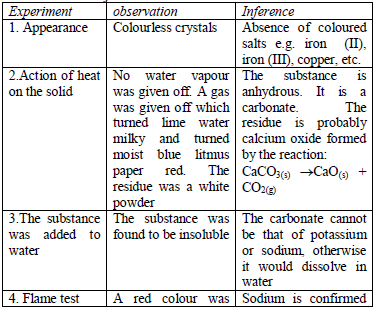THE CONCEPT OF QUALITATIVE ANALYSIS
Qualitative Analysis Procedures
The
procedures of qualitative analysis involve carrying out analytical
tests in the appropriate sequence of steps. The common procedures for
testing an unknown sample is to make its solution and then test this
solution for different ions present. The steps involved in the systemic
analysis of a given sample are as follows:
Preliminary tests
- Colour and smell
- Flame test
- Solubility in water
- Dry heating
- Action on litmus (for gases evolved)
Tests for acid radicals (anions)
- Dilute acid test (dilute H2SO4)
- Concentrated acid test (concentrated H2SO4)
- Wet test for acid radicals
Wet tests for basic radicals (cations)
Using Special Apparatus for Qualitative Analysis
Activity 1
Use special apparatus for qualitative analysis
Preliminary Test on an Unknown Sample
Carry out preliminary test on an unknown sample
Preliminary
tests include noting the appearance (colour, texture, feel, etc) of the
sample, detecting the smell of the gas liberated, observing the action
of a substance on litmus, and even the taste of the substance under
investigation. The preliminary tests give a clue about the type of the
elements present in a sample.)
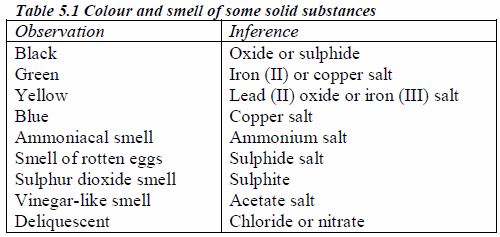
Table 5.2 Identification of gases
| Gas | Colour | Smell | Action on litmus | Test |
| CH3COOH | Colourless | Vinegar-like | Acidic | Liberated as dense white fumes |
| N2 | Colourless | Odourless | Neutral | No chemical test |
| Water vapour | Colourless | Odourless | Neutral | Turns white CuSO4 blue |
| NO2 | Reddish-brown | Pungent | Acidic | Not as red as Br2 vapour and does not condense on the sides of the test tube |
| NH3 | Colourless | Pungent | Alkaline | Forms thick white fumes when in contact with HCl gas |
| HCl | White fumes | Irritating | Acidic | Forms thick white fumes when in contact with NH3 gas |
| HBr & Br2 | White fumes & reddish- brown gas | Choking | Acidic & bleaches | HBr resembles HCl, & Br2, condenses to a red liquid on the sides of the test tube |
| Cl2 | Pale green | Bleaches | Choking | Gives white fumes with NH4OH |
| I2 | Violet | Choking | Bleaches | Turns starch iodide paper blue-black |
| CO2 | Colourless | Odourless | Slightly acidic | Turns lime water milky |
| CO | Colourless | Odourless | Neutral | Burns with pale blue flame |
| H2 | Colourless | Odourless | Neutral | Burns with a „pop‟ sound |
| H2S | Colourless | Rotten eggs | Acidic | Burns with blue flame to SO2, blackens lead acetate paper. |
| O2 | Colourless | Odourless | Neutral | Re-ignites a glowing splint |
| SO2 | Colourless | Irritating smell of burning sulphur | Acidic | Decolourizes KMnO4 solution, turns K2Cr2O7 from orange to green |
| SO3 | Colourless | Pungent | Acidic | Fumes in moist air forming dense white fumes |
Colours of some ions in solution
The appearance of a substance in solid or solution form can help in its identification:
- If a compound and its solution in water are colourless, it is probable that a transition metal is absent.
- If its colour is black, it is probably an oxide or a sulphide.
- If the solid and its solution in water are coloured, probably a transition metal is present.
The following are the colours of some transition element ions
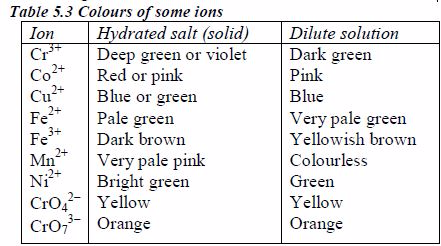
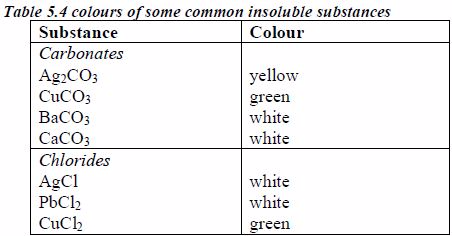
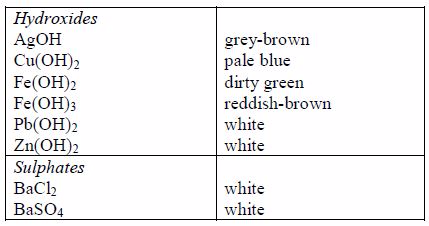
Preparation of Stock Solutions from Soluble and Insoluble Salts
The
solubilities of different compounds in water can be used in their
identification. It is therefore important to know the solubilities of
different compounds
To test the solubility of a compound, put one spatula of the compound in 1 cm3 of distilled water and stir. If the compound is soluble, this amount will dissolve. If the compound is moderately soluble, some of this amount will dissolve. If the compound is insoluble, not even a small amount will dissolve.
The following are some general rules on the solubility of different compounds in water:
- All common nitrates of metals are soluble.
- All common sodium, potassium and ammonium salts are soluble.
- All common chlorides are soluble except those of silver, mercury (I) and lead (II).
- All common sulphates are soluble except those of lead and barium. The sulphates of calcium and silver are sparingly soluble.
- All carbonates, sulphites and phosphates of sodium, potassium, and ammonium are soluble but other common carbonates are insoluble.
- Sodium, potassium and ammonium hydroxides [(ammonia solution, NH3(aq)]* are soluble but other common hydroxides are insoluble.
- All sulphides are insoluble except those of the alkali metals, the alkaline earth metals and ammonium.
It is important to note that ammonium hydroxide does not exist. The
solution of ammonia in water (ammonia solution) is always wrongly termed
as ammonium hydroxide. Although the name ammonium hydroxide suggests an
alkali with the formula [NH4+][OH–], it is actually impossible to
isolate samples of NH4+ and OH– ions from a solution of ammonia in water
since the ions are negligibly very few in solution except in extremely
dilute solutions.
Action of heat on the original substance
Different
substances decompose on heating to give different products. Many
compounds decompose on heating and leave solid residues. In performing
this test, the compound is heated in an ignition tube or dry test tube.
Heating is continued until no further change occurs. The gas evolved,
residue left or sublimate formed on heating may help to identify the
acid radical present in a compound.
Table 5.5 Action of heat on the test substance

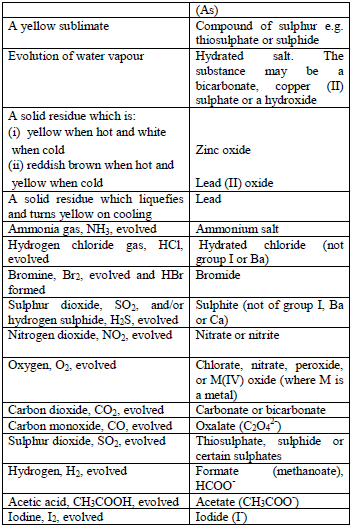
Action of dilute sulphuric acid or dilute hydrochloric acid
Treat
the solid with cold dilute sulphuric or hydrochloric acid. Identify the
gas evolved. If there is no reaction with the cold acid, heat the
mixture gently. Heat carefully and ensure the mixture does not boil. The
gas evolved can be identified as follows:
Table 5.6 Detection of acidic radicals

Action of concentrated sulphuric acid
As
in the above test, the acid is added to the solid substance and if no
reaction occurs, the mixture is warmed gently, but the mixture should
not be boiled. Then, the gas given off is identified. In addition,
observe any product, other than the gas, which results from the
reaction.
Table 5.7 Action of conc. H2SO4
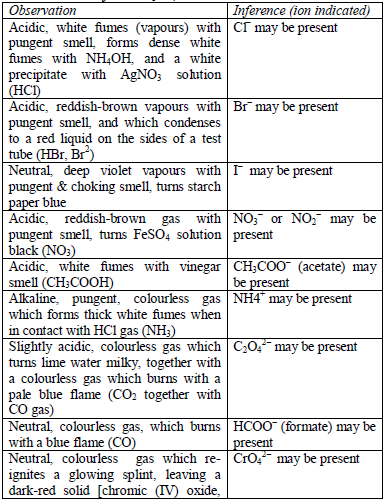

Note:
- Oxalates give CO2 with concentrated H2SO4 but not with. HCl.
- Nitrates do not give NO2 when treated with HCl but nitrites give NO2 gas.
- If no result is obtained in the above tests, the salt is probably a sulphate, chromate or phosphate.
Precipitation of soluble Salts from their Solutions
Precipitate insoluble salts from their solutions
Activity 2
Precipitate insoluble salts from their solutions
Confirm cations and anions identified
The
detection of acidic radicals is important in that, in addition to other
information, it enables a clear-cut identification of the substance
being analysed. The substances are first dissolved in distilled water to
make solutions. Then, the resulting solutions are tested for radicals.
Table 5.8 shows a list of test/experiments, each of which confirms the
presence of a given ion. Depending on the availability of reagents,
students can do any of the listed tests to confirm the ions present in
test solutions.
Table 5.8 confirmatory tests for anions
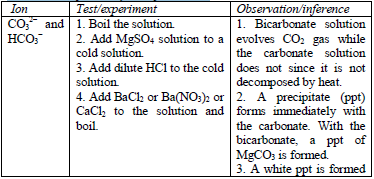
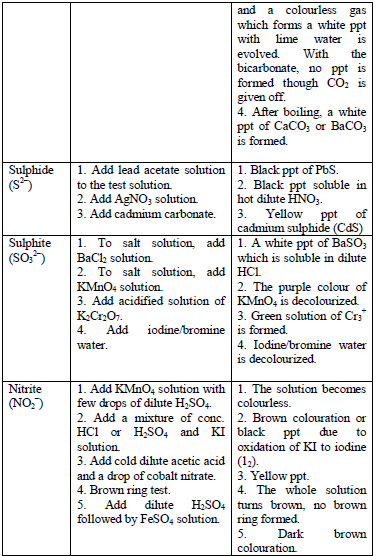
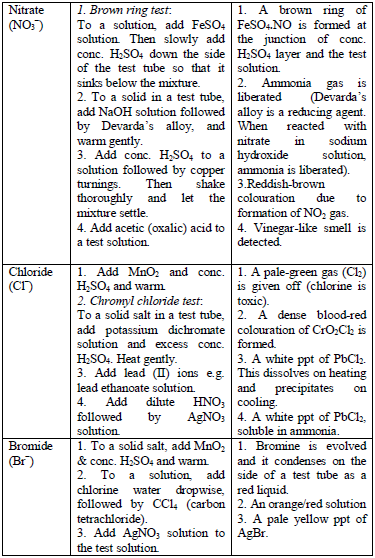
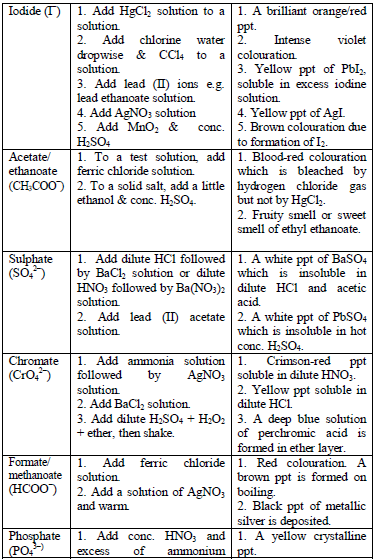
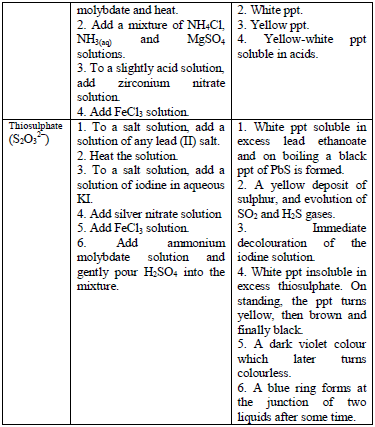
TESTS FOR METALLIC RADICALS
Flame test
Some
metal ions can be identified by the colour of their flame during a
flame test. Flame test involves mixing solutions of ions with conc. HCl
and then heating them on a platinum or nichrome wire over a non luminous
flame. Alternatively, a dry solid can be used instead of the
solution.To perform this experiment, dip a platinum or nichrome wire
into concentrated hydrochloric acid and hold it just above the blue part
of the flame. Repeat the process until the wire is clean. After that
dip the clean wire into the acid and the dip it into the solution of the
test substance (or its solid particles). Heat the substance strongly
and observe the colour of the flame formed.
The flame changes to a colour characteristics of the element. The following are characteristic flame colours of some metal ions.
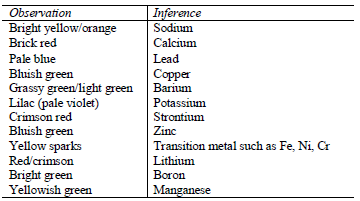
Action of hydrochloric acid
Add
dilute hydrochloric acid dropwise to the test solution until the
solution tests acidic to litmus paper. Observe for any reaction. A
precipitate will form with any cation that forms an insoluble chloride.
For example:

This can then be subjected to further tests to confirm the specific cation present in the solution.
Action of sulphuric acid
Add
dilute sulphuric acid dropwise to the test solution until the solution
is acidic. Observe for any reaction. A precipitate will form with any
cation that forms an insoluble sulphate. For example:

Action of sodium hydroxide
Add
sodium hydroxide solution, a little at a time, to the test solution
until there is an excess of it. Stir or shake the mixture and observe
for any reaction. If no precipitate is formed, warm the mixture gently
and test for ammonia. If a precipitate forms, continue adding the sodium
hydroxide solution.
Table 5.9 Reaction of cations with dilute NaOH
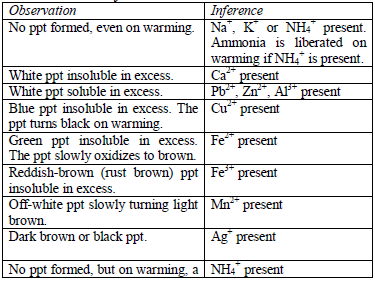

Reaction equations:
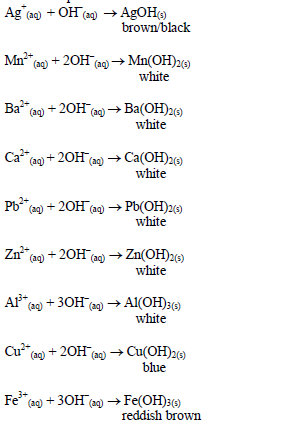

The
oxides of zinc, aluminium and lead are soluble in excess sodium
hydroxide. This is due to the amphoteric nature of the hydroxides of
these metals.

Action of aqueous ammonia
Add
dilute aqueous ammonia to the test solution, drop by drop. Stir or
shake the mixture and observe for any reaction. If a ppt forms, continue
adding aqueous ammonia.
Table 5.10 Reaction of cations with aqueous ammonia


An excess of aqueous ammonia dissolves the hydroxides of copper and zinc forming complex compounds of the metals:

Confirmatory tests for cations
After
the preliminary tests have been performed, there is always a need to
carry out confirmatory tests to confirm the presence of cations in
substances.
Table 5.11 Confirmatory tests for cations
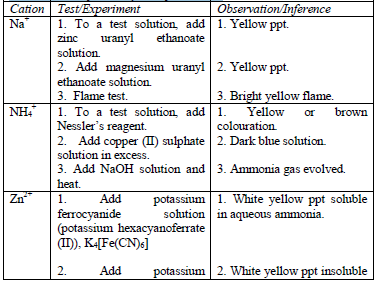
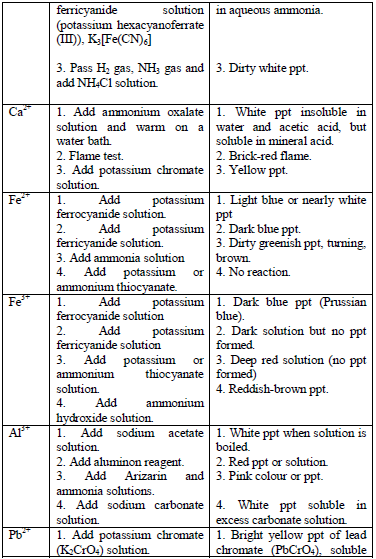
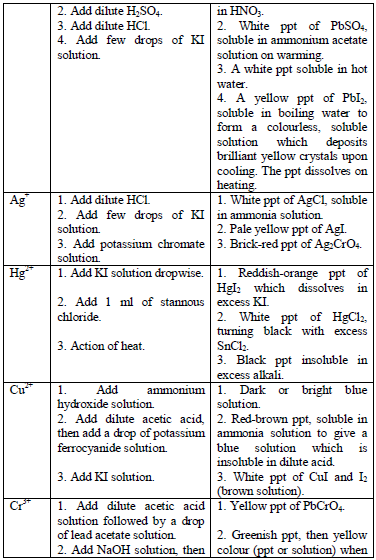
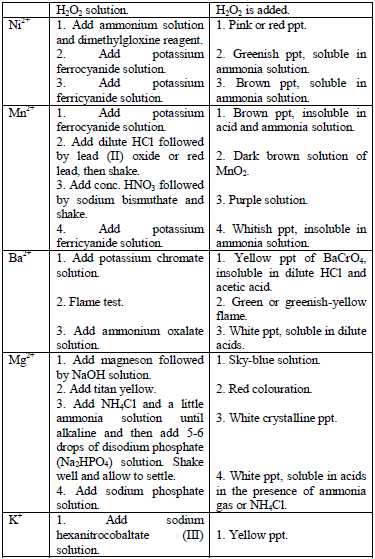

Confirmatory tests for iron salts
The
original test solution has to be divided into three portions. Then the
solutions should be treated with the following reagents and the results
recorded as shown in table 5.12.
- Potassium hexacyanoferrate (II) solution
- Potassium hexacyanoferrate (III) solution
- Potassium thiocyanate solution
Table 5.12 Tests for iron salts
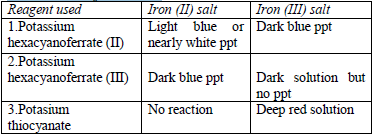
Table 5.13 Tests for bromides and iodides
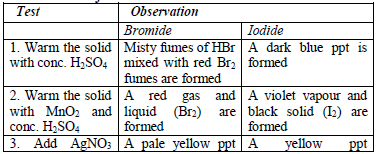

Write-up of analytical data
All
the observations made and any experimental data obtained during the
experiment (or test) must be presented in a tabular form a shown below.
Results presented in a table are concise, easy to read and understand.
The last column of the table gives the conclusions based on the
observations made.
Table 5.14 Table of results
